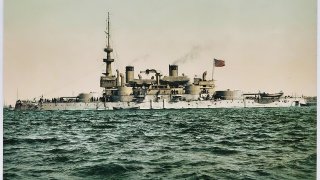USS Massachusetts: Why This Is the Worst U.S. Navy Battleship Ever
The USS Massachusetts (BB-2) was authorized in 1890 and commissioned six years later. In addition to barely being able to head out to sea, her turrets lacked counterweights, and if both of her then-giant twin 13-inch guns were turned to one side, the vessel would list severely. Likewise, the main belt armor was placed too low to be effective against enemy fire.
Summary: It sounds like the story of the USS Massachusetts is a rich tapestry of ambition, design limitations, and the harsh realities of early 20th-century naval engineering. The journey from the ill-fated USS Massachusetts (BB-2), a battleship beset by design flaws and misfortune, to the notable service of its successor during World War II highlights the rapid evolution of naval warfare and ship design. The legacy of BB-2, marred by mishaps and relegated to a training and target ship, contrasts sharply with the advanced capabilities and wartime achievements of the later USS Massachusetts (BB-59). This narrative encapsulates the challenges and triumphs of naval engineering, showcasing the perseverance and innovation that define maritime history.
Fill a room with even a small number of naval historians, and they are unlikely to reach a consensus on what was the best battleship ever built. Arguments will be made on the merits of many a capital ship.
But most naval experts will readily agree that the USS Massachusetts was the worst battleship ever built by the United States. In addition to being based on a terrible design, the ship suffered from several mishaps.
The hate for the USS Massachusetts might come as a surprise in Battleship Cove, Massachusetts, which is home to several warships, including the third of four South Dakota-class fast battleships.
That USS Massachusetts (BB-59) saw significant service during the Second World War, playing a crucial role in Operation Torch, where she engaged the French battleship Jean Bart off Casablanca in 1942. BB-59 later served in the Pacific, escorting carriers and bombarding shore targets until the end of the conflict.
Despite being designed under treaty restrictions, the U.S. Navy's South Dakota-class battleships were noted for remarkable capabilities. They carried 16-inch guns, were heavily armored, and could reach speeds over 27 knots.
So how did the USS Massachusetts come to be so detested?
Because it is actually the preceding vessel named for the Bay State that has the dubious distinction of being the worst U.S. Navy battlewagon ever produced.
The First USS Massachusetts: The Worst Ever
Though a "battleship" in name with heavy armor and ordnance, the Indiana-class pre-dreadnought was designed for coastal defense. Her decks were not safe from high waves on the open ocean.
The USS Massachusetts (BB-2) was authorized in 1890 and commissioned six years later. In addition to barely being able to head out to sea, her turrets lacked counterweights, and if both of her then-giant twin 13-inch guns were turned to one side, the vessel would list severely. Likewise, the main belt armor was placed too low to be effective against enemy fire.
In addition to a poor design, the ship was truly unlucky.
During a training maneuver and gunnery practice, she suffered an explosion in one of her 8-inch gun turrets that killed nine sailors. She further ran aground twice, requiring months of repairs each time.
She spent much of her service laid up in the reserve fleet and was recommissioned to serve as a training ship for gun crews during World War I. However, it could be argued that the USS Massachusetts' greatest success was in 1921, when she was scuttled in shallow water off Pensacola, Florida, and used as a target for experimental artillery.
BB-2's wreck was never scrapped and remains a popular diving spot, while the rusting hulk is considered the oldest battleship still in existence.
Author Experience and Expertise: Peter Suciu
Peter Suciu is a Michigan-based writer. He has contributed to more than four dozen magazines, newspapers, and websites with over 3,200 published pieces over a twenty-year career in journalism. He regularly writes about military hardware, firearms history, cybersecurity, politics, and international affairs. Peter is also a Contributing Writer for Forbes and Clearance Jobs. You can follow him on Twitter: @PeterSuciu. You can email the author: [email protected].


